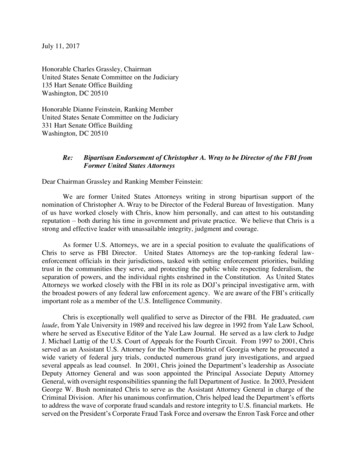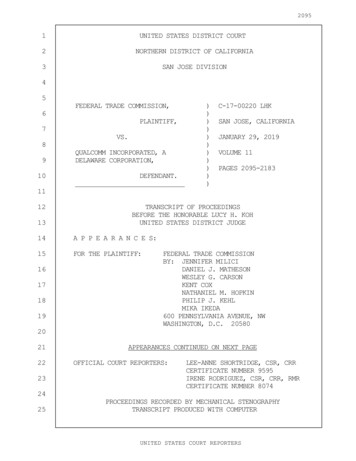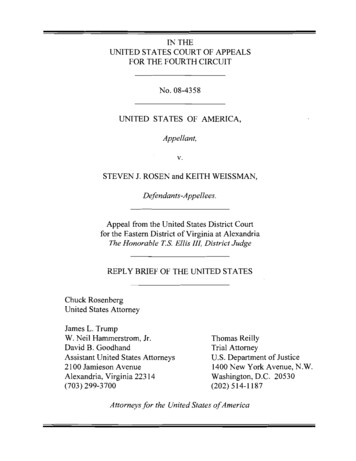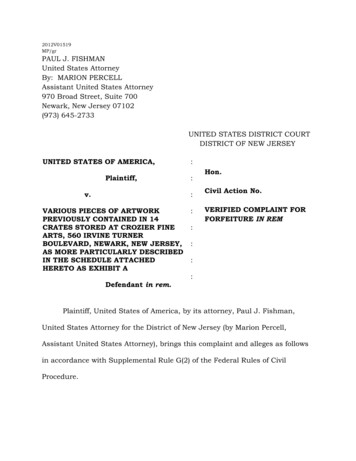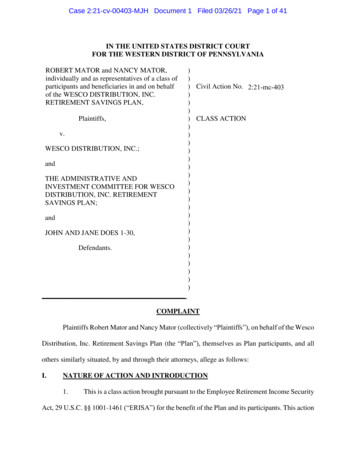
Transcription
Case 2:21-cv-00403-MJH Document 1 Filed 03/26/21 Page 1 of 41IN THE UNITED STATES DISTRICT COURTFOR THE WESTERN DISTRICT OF PENNSYLVANIAROBERT MATOR and NANCY MATOR,individually and as representatives of a class ofparticipants and beneficiaries in and on behalfof the WESCO DISTRIBUTION, INC.RETIREMENT SAVINGS PLAN,Plaintiffs,v.WESCO DISTRIBUTION, INC.;andTHE ADMINISTRATIVE ANDINVESTMENT COMMITTEE FOR WESCODISTRIBUTION, INC. RETIREMENTSAVINGS PLAN;andJOHN AND JANE DOES 1-30,Defendants.))) Civil Action No. 2:21-mc-403)))) CLASS ACTION)))))))))))))))))))))COMPLAINTPlaintiffs Robert Mator and Nancy Mator (collectively “Plaintiffs”), on behalf of the WescoDistribution, Inc. Retirement Savings Plan (the “Plan”), themselves as Plan participants, and allothers similarly situated, by and through their attorneys, allege as follows:I.NATURE OF ACTION AND INTRODUCTION1.This is a class action brought pursuant to the Employee Retirement Income SecurityAct, 29 U.S.C. §§ 1001-1461 (“ERISA”) for the benefit of the Plan and its participants. This action
Case 2:21-cv-00403-MJH Document 1 Filed 03/26/21 Page 2 of 41asserts claims for breaches of fiduciary duties and other violations of 29 U.S.C. §1132(a)(2) and(3) against the Plan’s fiduciaries, which include: Wesco Distribution, Inc; the Administrative andInvestment Committee for the Wesco Distribution, Inc. Retirement Savings Plan; and John andJane Does 1-30 (collectively, “Defendants”).2.Every year, millions of employees entrust their retirement savings to plansestablished under ERISA. ERISA plans are supposed to be protected by their fiduciaries, who areobligated to act loyally and prudently to protect plan participants and their hard-earned retirementdollars.3.As of September 2020, Americans had approximately 9.3 trillion in assets investedin defined contribution plans, such as 401(k) and 403(b) plans. See INVESTMENT COMPANYINSTITUTE, Retirement Assets Total 33.1 Trillion in Third Quarter 2020 (Dec. 16, t/ret 20 q3. Defined contribution plans have largelyreplaced defined benefit plans—or pension plans—that were predominant in previous generations.See James McWhinney, The Demise of the Defined-Benefit Plan, Investopedia (Updated Nov. 16,2020), 6/demiseofdbplan.asp. Today, only17% of private sector employees have access to a defined benefit plan, while 64% have access toa defined contribution plan. Id.4.The essential remedial purpose of ERISA is to protect the beneficiaries of privateretirement plans. ERISA fiduciaries have a continuing duty to evaluate fees and expenses beingassessed to a plan in order to make sure those charges are reasonable and prudent.5.Failures by ERISA fiduciaries to monitor costs for reasonableness have starkfinancial consequences for retirees. Every extra level of expenses imposed upon plan participantscompounds over time and reduces the value of participants’ investments available upon retirement.2
Case 2:21-cv-00403-MJH Document 1 Filed 03/26/21 Page 3 of 416.The potential for imprudence is much greater in defined contribution plans than indefined benefit plans. In a defined benefit plan, the participant is entitled to a fixed monthlypension payment, while the employer is responsible for making sure the plan is sufficientlycapitalized, and thus the employer bears all risks related to excessive fees and investmentunderperformance. Therefore, in a defined benefit plan, the employer and the plan’s fiduciarieshave every incentive to keep costs low and to remove imprudent investments. But in a definedcontribution plan, participants’ benefits are limited to the value of their own investment accounts,which is determined by the market performance of contributions, less expenses. Thus, in a definedcontribution plan, risks related to high fees and poorly performing investments are borne by theemployee.7.The table below illustrates how retirement plan services (“RPS”) fees impactretirement accounts over time.1 The table illustrates that when an employee invests 100,000 over20 years with an assumed 4% annual rate of return and annual fees of 1.00%, the account balancein 20 years will be 180,000. This balance is 30,000 less than the same investment where annualfees are only 0.25%, which would result in a balance of 210,000. This difference of over 14percent is substantial. In fact, the impact of excessive fees on defined contribution participants iseven more substantial given that during most of the past three decades the returns of definedcontribution participants have averaged almost double (7%) the 4% in the below SEC example(see, e.g., Net Weighted Geometric Rate of Return of Defined Contribution Plans from 1990-2012as calculated by the Center for Retirement Research, Investment Returns: Defined Benefit vs.Defined Contribution Plans, December 2015, Number 15-21, p. 3, Table 4. Center for RetirementResearch).1See https://www.sec.gov/files/ib mutualfundfees.pdf (last visited Mar. 24, 2021).3
Case 2:21-cv-00403-MJH Document 1 Filed 03/26/21 Page 4 of 418.Indeed, the Third Circuit Court of Appeals recently noted:Expenses, such as management or administrative fees, can sometimes significantlyreduce the value of an account in a defined-contribution plan . . . by decreasing itsimmediate value, and by depriving the participant of the prospective value of fundsthat would have continued to grow if not taken out in fees.29.The Defendants are ERISA fiduciaries pursuant to 29 U.S.C. § 1002(21)(A),because they exercise discretionary authority or discretionary control over the Plan, whichDefendants sponsor and administer.10.ERISA imposes strict fiduciary duties of prudence upon Defendants as Planfiduciaries, pursuant to 29 U.S.C. § 1104(a). ERISA’s fiduciary duties are among “the highestknown to the law.” Sweda, 923 F.3d at 333 (internal citation and quotations omitted). Fiduciariesmust act “solely in the interest of the participants and beneficiaries,” 29 U.S.C. § 1104(a)(1), withthe “care, skill, prudence, and diligence” that would be expected in managing a plan of similarscope. 29 U.S.C. § 1104(a)(1)(B). As fiduciaries to the Plan, Defendants were and are obligated to2Sweda v. Univ. of Pa., 923 F.3d 320, 328 (3d Cir. 2019), cert. denied, 140 S. Ct. 2565 (2020)(internal citation and quotations omitted).4
Case 2:21-cv-00403-MJH Document 1 Filed 03/26/21 Page 5 of 41prudently ensure that Plan fees and expenses are reasonable.11.Defined contribution retirement plans are often categorized in terms of the value ofthe assets in the plan. For example, plans with less than 5 million in assets are often classified as“micro” plans, plans with between 5 and 50 million in assets are considered “small” plans, planswith assets between 50 and 200 million in assets are considered “mid” plans, and plans withgreater than 200 million in assets are considered “large” plans.12.With 8,870 participants and more than 750 million in net assets as of December31, 2019, based on publicly-available Form 5500 data, the Plan is larger than 99.60% of definedcontribution plans in terms of participants and larger than 99.83% in terms of assets and is thusconsidered a “large” retirement plan.13.The marketplace for RPS is well-established and highly competitive. Having hadbetween 500- 750 million in assets, the Plan was a “large” plan since at least 2015 and, as aresult, had tremendous bargaining power to demand low-cost administrative and investmentmanagement services.14.Prudent plan fiduciaries continuously monitor both (1) investment fees againstapplicable benchmarks and peer groups, and (2) the market for reasonable RPS fees, in order toidentify objectively unreasonable and unjustifiable fees.15.But instead of leveraging the Plan’s substantial bargaining power to benefit Planparticipants and beneficiaries, Defendants caused the Plan to imprudently pay unreasonable andexcessive fees for RPS in relation to the services being provided to the Plan.16.Upon information and belief, during the Class Period, Defendants breached theirduties owed to the Plan, to Plaintiffs, and all other Plan participants by:a.Imprudently failing to monitor the RPS fees paid by the Plan to ensure that5
Case 2:21-cv-00403-MJH Document 1 Filed 03/26/21 Page 6 of 41they were reasonable and, as a result, authorizing the Plan to pay objectively unreasonableand excessive RPS fees, relative to the RPS received;b.Imprudently failing to understand the methodology by which fee paymentssuch as revenue sharing are paid to RPS providers; andc.Imprudently failing to take standard and customary actions to understandthe market for RPS in order to monitor for reasonableness the RPS fees paid by the Plan inrelation to the RPS received.17.The objectively unreasonable RPS fees charged to the Plan by Defendants cannotbe justified. During the Class Period, the Plan paid between 159 and 194 per participant annuallyfor RPS. During the Class Period, reasonable RPS fees for a plan of this size would have averaged 41 per participant annually.18.Defendants’ failures to monitor RPS fees and ensure their reasonableness breachedthe fiduciary duties they owed to Plaintiffs, Plan participants, and beneficiaries. Prudent fiduciariesof 401(k) plans continuously monitor the market for RPS to ensure the fees paid by the plan arereasonable. Defendants did not engage in prudent decision-making processes, but decided insteadto remain with Wells Fargo Bank, N.A. (“Wells Fargo”) and not seek competitive bids or otherwisedetermine the market for RPS. There is no other explanation for why the Plan paid objectivelyunreasonable fees for RPS.19.Plaintiffs were injured by the Defendants’ actions because Defendants permitted allPlan participants to be charged excessive RPS fees, which reduced Plaintiffs’ and other Planparticipants’ account balances and caused them significantly diminished investment returns.20.To remedy Defendants’ fiduciary breaches, Plaintiffs, individually and asrepresentatives of a class of participants and beneficiaries in the Plan, bring this action on behalf6
Case 2:21-cv-00403-MJH Document 1 Filed 03/26/21 Page 7 of 41of the Plan under 29 U.S.C. § 1132(a)(2) and (3) to enforce Defendants’ personal liability under29 U.S.C. § 1109(a) to restore to the Plan all losses resulting from each breach of fiduciary duty,as alleged in more detail herein. In addition, Plaintiffs seek such other equitable or remedial relieffor the Plan as the Court may deem appropriate.21.The allegations in this Complaint are based upon information and belief and aninvestigation by undersigned counsel, including, but not limited to, review of Plan filings with theUnited States Department of Labor (“DOL”), other publicly available documents, and otheranalytical investment data. Defendants have possession of additional material information relatingto the claims herein, and Plaintiffs reserve the right to amend this Complaint as those materialsbecome available in the course of this litigation.II.JURISDICTION AND VENUE22.This Court has exclusive jurisdiction over the subject matter of this action under 29U.S.C. § 1132(e)(1) and 28 U.S.C. § 1331, which provide for federal jurisdiction of actions broughtunder Title I of ERISA, 29 U.S.C. §§ 1001 et seq.23.This Court has personal jurisdiction over Defendants because they transact businessin this District, reside in this District, have significant contacts within this District, and becauseERISA provides for nationwide service of process.24.This District is the proper venue for this action under 29 U.S.C. § 1132(e)(2)because the Plan is administered in this District; the Plan is deemed to reside in this District; someor all of the ERISA violations alleged herein took place in this District; and the Plan can be foundin this District. Venue is also proper in this District pursuant to 28 U.S.C. § 1391 becauseDefendants do business in this District and a substantial part of the events or omissions giving riseto the claims asserted herein occurred within this District.7
Case 2:21-cv-00403-MJH Document 1 Filed 03/26/21 Page 8 of 41III.PARTIESA.Plaintiff Robert Mator25.Plaintiff Robert Mator is a resident of Cerritos, California. Mr. Mator is a current“participant” in the Plan, as that term is defined under 29 U.S.C §1002(7), because he has a vestedaccount balance in the Plan and his beneficiaries are or may become eligible to receive benefitsunder the Plan. At all relevant times, Mr. Mator was and is a participant in the Plan. During theClass Period, Mr. Mator paid excessive RPS fees directly and indirectly through revenue sharing.26.During the Class Period, Mr. Mator held investments in Plan investment optionsthat paid revenue sharing fees.27.Mr. Mator has Article III standing to bring this action on behalf of himself becausehe suffered an actual injury to his own individual Plan account in which he is still a participant,that injury is fairly traceable to Defendants’ breaches of fiduciary duties in violation of ERISA,and the harm is likely to be redressed by a favorable judgment.28.The Plan also suffered harm caused by Defendants’ fiduciary breaches and remainsexposed to harm and continued future losses. The Plan is the victim of a fiduciary breach and willbe the recipient of any recovery. Mr. Mator’s claims are brought in a representative capacity onbehalf of the Plan as a whole and seek remedies under 29 U.S.C. § 1109 to protect the entire Plan.Mr. Mator and all participants and beneficiaries in the Plan suffered ongoing financial harm as aresult of Defendants’ continued imprudent and unreasonable investment and fee decisions. Thoseinjuries may be redressed by a judgment of this Court in favor of Mr. Mator.29.Mr. Mator did not have knowledge of all material facts (including, among otherthings, the retirement plan services and total cost comparisons to similarly-sized plans) necessaryto understand that Defendants breached (and continue to breach) their fiduciary duties and engaged8
Case 2:21-cv-00403-MJH Document 1 Filed 03/26/21 Page 9 of 41in other unlawful conduct in violation of ERISA until shortly before this suit was filed. Mr. Matorlacked actual knowledge of reasonable fee levels and prudent fee alternatives available to the Plan.B.Plaintiff Nancy Mator30.Plaintiff Nancy Mator is a resident of Cerritos, California. Ms. Mator is a current“participant” in the Plan, as that term is defined under 29 U.S.C §1002(7), because she has a vestedaccount balance in the Plan and her beneficiaries are or may become eligible to receive benefitsunder the Plan. At all relevant times, Ms. Mator was and is a participant in the Plan. During theClass Period, Ms. Mator paid excessive RPS fees directly and indirectly through revenue sharing.31.During the Class Period, Ms. Mator held investments in Plan investment optionsthat paid revenue sharing fees.32.Ms. Mator has Article III standing to bring this action on behalf of herself becauseshe suffered an actual injury to her own individual Plan account in which she is still a participant,that injury is fairly traceable to Defendants’ breaches of fiduciary duties in violation of ERISA,and the harm is likely to be redressed by a favorable judgment.33.The Plan also suffered harm caused by Defendants’ fiduciary breaches and remainsexposed to harm and continued future losses. The Plan is the victim of a fiduciary breach and willbe the recipient of any recovery. Ms. Mator’s claims are brought in a representative capacity onbehalf of the Plan as a whole and seek remedies under 29 U.S.C. § 1109 to protect the entire Plan.Ms. Mator and all participants and beneficiaries in the Plan suffered ongoing financial harm as aresult of Defendants’ continued imprudent and unreasonable investment and fee decisions. Thoseinjuries may be redressed by a judgment of this Court in favor of Ms. Mator.34.Ms. Mator did not have knowledge of all material facts (including, among otherthings, the retirement plan services and total cost comparisons to similarly-sized plans) necessary9
Case 2:21-cv-00403-MJH Document 1 Filed 03/26/21 Page 10 of 41to understand that Defendants breached (and continue to breach) their fiduciary duties and engagedin other unlawful conduct in violation of ERISA until shortly before this suit was filed. Ms. Matorlacked actual knowledge of reasonable fee levels and prudent fee alternatives available to the Plan.C.Defendants35.Defendant Wesco Distribution, Inc. (“Wesco”)3 is a company with a principal placeof business located at 225 West Station Square Drive, Suite 700, Pittsburgh, Pennsylvania 15219.Per the Plan’s Forms 5500, Wesco is the Plan Administrator under 29 U.S.C. § 1002(16)(A)(i) andthe Plan Sponsor under 29 U.S.C. § 1002(16)(B). As the Plan Administrator, Wesco is a fiduciaryresponsible for day-to-day administration and operation of the Plan, within the meaning of 29U.S.C. § 1002(21)(A). It has authority and responsibility for the control, management, andadministration of the Plan in accordance with 29 U.S.C. § 1102(a). Wesco has responsibility anddiscretionary authority to control the operation, management, and administration of the Plan, withall powers necessary to enable it to carry out such responsibilities properly, including the selectionand compensation of the providers of recordkeeping and administrative services to the Plan. Wescoacted through its officers, directors, and the other Defendants to perform Plan-related fiduciaryfunctions in the course and scope of their business. Wesco appointed other Plan fiduciaries, andaccordingly had a concomitant fiduciary duty to monitor and supervise those appointees.36.Defendant Administrative and Investment Committee for the Wesco Distribution,Inc. Retirement Savings Plan (“Committee”) is, on information and belief, located at 225 WestStation Square Drive, Suite 700, Pittsburgh, Pennsylvania 15219. The Committee and its members,in their individual capacities, are fiduciaries within the meaning of 29 U.S.C. § 1002(21)(A).In this Complaint, “Wesco” refers to the named Defendant Wesco Distribution, Inc. and allparent, subsidiary, affiliated, predecessor, and successor entities to which these allegationspertain.310
Case 2:21-cv-00403-MJH Document 1 Filed 03/26/21 Page 11 of 41According to the Plan’s Forms 5500, the Committee is the Plan administrator.37.Defendants John and Jane Does 1-30 are unknown individuals comprised ofDefendants the Board of Directors and the Committee; any officers, directors, or employees ofDefendant Wesco; or other individuals or entities who are or were fiduciaries to the Plan, withinthe meaning of 29 U.S.C. § 1002(21)(A), during the Class Period. Plaintiffs reserve the right toseek leave to join these currently unknown individuals into the instant action once their identitiesare ascertained.38.All Defendants are Plan fiduciaries because they have exercised and continue toexercise discretionary authority or discretionary control respecting the management of the Planand the management and disposition of its assets, and have discretionary authority or discretionaryresponsibility in the administration of the Plan. 29 U.S.C. § 1002(21)(A).D.THE WESCO DISTRIBUTION, INC. RETIREMENT SAVINGS PLANThe name of the Plan is the Wesco Distribution, Inc. Retirement Savings Plan. The Plan’sEmployer Identification Number (EIN) is 25-1723345 and the Plan has been assigned the threedigit plan number 001.39.The Plan is subject to ERISA and is, on information and belief, established andmaintained under written documents in accordance with 29 U.S.C. § 1102(a)(1).IV.FACTUAL BACKGROUNDA.OVERVIEW OF RETIREMENT PLAN SERVICES IN DEFINEDCONTRIBUTION PLANS40.In recent decades, the defined contribution plan has become the most common typeof employer-sponsored retirement plan. The assets of a defined contribution plan are held by atrustee in a single trust. The plan allocates the trust assets among plan participants through an RPSprovider (often referred to generically as a “recordkeeper”) that tracks each participant’s account,11
Case 2:21-cv-00403-MJH Document 1 Filed 03/26/21 Page 12 of 41which consists of his/her share of plan investments and returns.41.Fiduciaries of virtually all “large” defined contribution plans hire one RPS providerto provide the essential Recordkeeping & Administrative (“RK&A”) services for a plan. RK&Aservices are necessary for defined contribution plans, and the services often include, but are notlimited to, maintaining plan records, tracking participant account balances and investmentelections, providing transaction processing, providing call center support and investment educationand guidance, providing participant communications, and providing trust and custodial services.42.RPS includes the RK&A services as well as fees for other services such asindividual transactions and/or services that are utilized only by specific participants, e.g., loaninitiation and maintenance fees, Qualified Domestic Relations Order services, etc. The feescharged for participant-specific services typically account for an immaterial portion of the totalfees charged for providing RPS.43.Some providers of RPS provide purely RK&A, while others are subsidiaries offinancial services companies and insurance companies that distribute mutual funds, insuranceproducts, and other investment options.44.Since the mid-2000s, the retirement plan services provided to “large” definedcontribution plans, like the Plan, have increasingly become viewed by prudent plan fiduciaries asa commodity service. While RPS providers in the defined contribution industry attempt todistinguish themselves through marketing and other means, most RPS providers offer the samebundles and combinations of services as their competitors. As a result, the market for definedcontribution retirement plan services is highly competitive, particularly for “large” plans that, likethe Plan, have a sizable number of participants and a large amount of assets.45.In recent decades, the fee that RPS providers have been willing to accept for12
Case 2:21-cv-00403-MJH Document 1 Filed 03/26/21 Page 13 of 41providing retirement plan services has significantly decreased.46.By the start of and during the entire Class Period, the level of fees that RPSproviders have been willing to accept for providing RPS, including RK&A services, has stabilized,and has not materially changed. In other words, reasonable RPS fees paid in 2018 arerepresentative of the reasonable fees for retirement plan services during the entire Class Period.47.RPS providers for larger defined contribution plans, like the Plan, experienceadvantages that lead to a reduction in the per-participant cost as the number of participants in theplan increases. This is because the marginal cost of adding an additional participant to arecordkeeping platform is relatively low. These economies of scale are inherent in allrecordkeeping arrangements for defined contribution plans. When the number of participantsincreases in a defined contribution plan, the RPS provider can spread the cost of providingretirement plan services over a larger participant base, reducing the average unit cost of deliveringservices on a per-participant basis.48.Moreover, the cost to an RPS provider to provide services to a participant does notmaterially differ from one participant to another and is not dependent on the balance of theparticipant’s account. In other words, the average cost to provide RPS is materially identical for aparticipant that has 10,000 and a participant that has 100,000 or 1,000,000 in plan assets.49.Therefore, while the total cost to provide RPS increases as more participants jointhe plan, the cost per participant to deliver the RPS decreases. Prudent plan fiduciaries and theirconsultants and advisors are aware of this cost structure dynamic for retirement plan providers.50.Sponsors of defined contribution plans negotiate and contract for RPS separatelyfrom any contracts related to the selection of investment management services provided to planparticipants.13
Case 2:21-cv-00403-MJH Document 1 Filed 03/26/21 Page 14 of 4151.Often, a portion of the total expense ratio for the investment options selected byplan fiduciaries is allocated to the provision of services that the RPS provider provides on behalfof the investment manager.52.As a result, RPS providers often make separate contractual arrangements withmutual fund providers. RPS providers often collect a portion of the total expense ratio fee of themutual fund in exchange for providing services that would otherwise have to be provided by themutual fund. These fees are known in the defined contribution industry as “revenue sharing.”53.For example, if a mutual fund has a total expense ratio fee of 0.75%, the mutualfund provider may agree to pay the RPS provider 0.25% of the 0.75% total expense ratio fee thatis paid by the investor in that mutual fund (in this context the Plan participant). That 0.25% portionof the 0.75% total expense ratio fee is known as the “revenue sharing.”54.In the context of defined contribution plans, the amount of revenue sharing isdeemed to be the amount of revenue paid by participants that is allocable to RPS and, in somecases, other services provided to a plan. The difference between the total expense ratio and therevenue sharing is known as the “net investment expense.” When a plan adopts prudent and bestpractices, the net investment expense is the actual amount a plan participant pays for the investmentmanagement services provided by a portfolio manager.55.RPS providers typically collect their fees through direct payments from the plan orthrough indirect compensation such as revenue sharing, or some combination of both.56.Regardless of the pricing structure that the plan fiduciaries negotiate with the RPSprovider, the amount of compensation paid to the RPS provider must be reasonable.57.As a result, plan fiduciaries must understand the total dollar amounts being paid totheir RPS provider(s) and be able to determine whether the compensation is reasonable by14
Case 2:21-cv-00403-MJH Document 1 Filed 03/26/21 Page 15 of 41evaluating what the market is for the RPS being received by the plan.58.Because RPS fees are actually paid in dollars and because of the cost dynamic notedabove, the fees paid for RPS are evaluated and compared on a dollars-per-participant basis.59.It is axiomatic in the RPS industry that, all else being equal, a plan with moreparticipants can and will receive a lower effective per-participant fee when evaluated on a perparticipant basis, and that as participant counts increase, the effective per-participant RPS feeshould decrease, assuming the same services are provided.B.60.STANDARD OF CARE FOR PRUDENT FIDUCIARIESSELECTING AND MONITORING RPS PROVIDERSPlan fiduciaries are required to fully understand all sources of revenue received byRPS providers. Fiduciaries must regularly monitor the revenue being paid to RPS providers toensure that the compensation received is and remains reasonable in view of the services beingprovided.61.The DOL has identified that employers are held to a “high standard of care anddiligence” and must, among other duties, “[e]stablish a prudent process for selecting . . . serviceproviders”; “[e]nsure that fees paid to service providers and other plan expenses are reasonable inlight of the level and quality of services provided”; and “[m]onitor . . . service providers onceselected to make sure they continue to be appropriate choices.”462.The duty to evaluate and monitor plan service provider fees includes those feesdirectly paid by participants, because “[a]ny costs not paid by the employer, which may includeadministrative, investment, legal, and compliance costs, effectively are paid by plan participants.”5See United States Dep’t of Labor, A Look at 401(k) Plan Fees, at 2 (Sept. ons/a-look-at-401k-plan-fees.pdf.5Investment Company Institute, The Economics of Providing 401(k) Plans: Service, Fees, andExpenses, at 4-5 (June 2018), https://www.ici.org/pdf/per24-04.pdf.415
Case 2:21-cv-00403-MJH Document 1 Filed 03/26/21 Page 16 of 4163.Prudent fiduciaries will ensure that a plan is paying no more than reasonable feesfor RPS by soliciting competitive bids from other RPS providers to perform the same servicescurrently being provided to the plan. This process is not difficult or complex and is performedregularly by prudent plan fiduciaries. For plans with many participants, like the Plan, most RPSproviders would require only the number of participants and the amount of the assets to provide aquote for RPS, while others might only require the number of participants.64.Prudent fiduciaries have all of this information readily available and can easilyreceive a quote from other RPS providers to determine if the current level of fees being charged tothe plan is reasonable.65.Having received bids, a prudent fiduciary can negotiate with its current providerfor a lower fee or move to a new RPS provider to provide the same (or better) services for acompetitive (or lower) reasonable fee. Prudent fiduciaries follow this same process to monitor thefees of retirement plan advisors and/or consultants as well as any other covered service providers.66.After the revenue requirement is negotiated, the plan fiduciary determines how topay the negotiated RPS fee. The employer/plan sponsor can pay the RPS fees on behalf ofparticipants, which is the most beneficial to plan participants. If the employer were paying the fee,the employer would have an interest in negotiating the lowest fee a suitable RPS provider wouldaccept. Typically, however, the employer decides to have the plan (i.e., participants) pay the RPSfees. If the RPS fees are paid by participants, the fiduciaries can allocate the negotiated RPS
to remain with Wells Fargo Bank, N.A. ("Wells Fargo") and not seek competitive bids or otherwise determine the market for RPS. There is no other explanation for why the Plan paid objectively unreasonable fees for RPS. 19. Plaintiffs were injured by the Defendants' actions because Defendants permitted all





